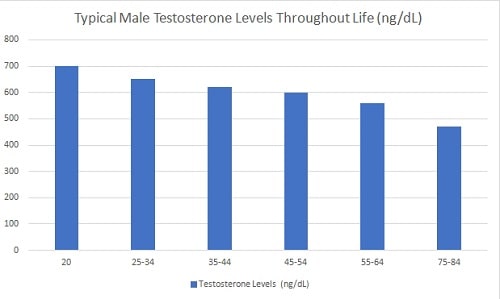Testosterone replacement therapy, abbreviated as TRT in many circles, involves the therapeutic administration of testosterone to men (and sometimes women) who have abnormally low levels of the hormone in their bodies (a medical condition called “testosterone deficiency”). TRT is part of the hormone replacement therapy sector of medicine, a rapidly advancing field of medicine that holds promise for restoring quality of life in affected individuals.
Testosterone deficiencies primarily affect men above the age of 40. This is due to the consistent loss of testosterone typically seen among men as they age – usually amounting to about a 1% drop-off in circulating “free testosterone” levels (the type of usable testosterone that confers secondary male sexual characteristics and performs other critical biological functions in health maintenance). “Male hypogonadism” is the medical term for underperforming testicles that do not produce adequate supplies of endogenous testosterone.

However, testosterone deficiencies, contrary to popular belief, are not only an issue for aging men. In fact, worrying numbers of younger and even adolescent males are increasingly susceptible to the health-damaging effects of low testosterone.
According to a 2020 study titled Trends in Serum Testosterone Levels Among Adolescent and Young Adult Men in the United States that was presented at a major medical conference earlier this year, up to 20% of adolescent males experience testosterone deficiencies in the modern era – a stunning figure that does not bode well for the future of public health.
Erectile-dysfunction and lowered sexual desire in men are only two of the many effects of low T. Low testosterone, in both younger and older males, can cause the following detrimental health effects:
- Lowered sperm count.
- Low libido (sex drive).
- Muscle weakening (atrophy).
- Lowered bone density (triggering osteoporosis).
- Mental health deterioration.
- Poor energy levels.
- Inhibited metabolism (leading to obesity and potentially diabetes).
- Impaired cardiovascular function.
In addition to affecting men, testosterone deficiencies can also negatively impact women’s health. Although women generally have much lower levels of testosterone (10-20 times less on average), testosterone deficiencies can still adversely impact their health.
Testosterone replacement therapy often helps women as well as men live healthier, more active lives. Menopausal and postmenopausal women, in particular, may benefit from boosting their testosterone levels through TRT.
Testosterone is produced in various human organs:
- Testes (for men).
- Ovaries (for women).
- Adrenal glands.
In the coming years, we can expect to see more and more patients turn to medical interventions via TRT supplementation to correct hormonal deficiencies. If you or a loved one is concerned about a potential testosterone deficiency, read on to discover how to best seek the medical attention that you need to restore your hormonal health at the lowest possible cost without sacrificing safety.
Does Testosterone Replacement Therapy Require a Prescription in the US?
Yes, to legally obtain a prescription to begin TRT, patients must first visit a doctor who will examine their testosterone levels, check blood markers through testing, investigate any underlying conditions, and discuss your symptoms to determine if you are a good candidate to receive the therapy.
Sourcing your testosterone illegally on the black market and/or attempting to perform TRT yourself or with the help of an unlicensed or inexperienced provider is dangerous for many reasons that we will discuss later.
How to Get a Doctor to Prescribe Testosterone
So, what is the medically proper (and legal) way that patients with low T can acquire prescribed testosterone? The first step is to schedule an appointment with a licensed medical provider who specializes in TRT (ideally one with expertise in hormone health called an endocrinologist).
When you visit the clinic, the provider will sit down with you to assess your health concerns. If he or she suspects a testosterone deficiency, the next step in the therapy process is to order relevant tests to clinically determine a deficiency.
Otherwise healthy men with no underlying health issues, aside from being deficient in bioavailable forms of the steroid-hormone, have no problems acquiring a legal TRT prescription. If lab work confirms the presence of a testosterone deficiency, a therapeutic protocol is then developed to correct the imbalance, including a written testosterone prescription from the doctor.
The Dangers of Unprescribed Testosterone
As we mentioned earlier, aside from being against the law with the potential for jail time and heavy fines, attempting to self-administer testosterone bought on the black market imperils your health in a number of ways.
Low-Quality and Fake Testosterone on the Black Market
First of all, you want to be sure as a patient that you are receiving pure testosterone that is free of harmful additives or chemicals. Much of the testosterone that can be purchased illegally does not meet the strict safety and quality standards set forth by the Federal Drug Administration (FDA). The web is full of cautionary tales of subpar testosterone supplements (all purchased illegally without a prescription) that resulted in significant health damage in those who used them.
The Shocking Truth Behind Fake and Substandard Medicines
One recent study by the World Health Organization (WHO) – widely considered a leading authority on medical supply safety – found that more than 1 out of 10 medical supplies from the Third World were either fake or substandard, meaning that they either did not contain the medicine that they claimed to or that they contained harmful additives that potentially endanger the wellness of those who take them.
The issue of substandard and fake testosterone can be eliminated by visiting a licensed, reputable TRT provider who responsibly sources the testosterone used in therapy.
The Need for Continual Health Monitoring Throughout TRT
In addition to avoiding subpar medications, getting a legitimate prescription from an experienced TRT provider is essential to ensure that your body responds as it should to therapy.
 When you visit a TRT provider prior to beginning therapy, the doctor will screen for the following underlying conditions that might contraindicate therapy:
When you visit a TRT provider prior to beginning therapy, the doctor will screen for the following underlying conditions that might contraindicate therapy:
- Diabetes.
- Sleep apnea.
- Active prostate cancer.
- Breast cancer.
- Unchecked cholesterol.
Although these conditions may not necessarily disqualify patients who require TRT, they must be properly treated prior to beginning therapy to avoid potential negative side effects that can sometimes occur as a result of receiving testosterone.
The Stages of Getting Testosterone Prescribed (Online and Offline)
We’ve briefly touched on the process of obtaining a TRT prescription. Here, we’ll break down the process step-by-step (both offline and online, respectively).
How to Get a TRT Prescription Offline
Getting a TRT prescription “offline” by physically visiting a clinic is the more traditional method of obtaining a TRT prescription. It is generally more time-consuming and expensive than getting it online; however, some patients may prefer this method. The steps of obtaining a TRT prescription offline are:
- The patient with a suspected deficiency schedules an appointment with a clinic.
- The patient visits the clinic in-person, consults with the doctor, and submits the necessary lab work (blood tests). Some clinics may have labs on-site (more convenient) while others may require an additional trip to a lab testing center to perform the necessary blood work.
- Once the results from the lab work are in (typically in a week or less), the clinic will contact the patient to return to the clinic and review the results with the doctor.
- The doctor then prescribes testosterone as necessary, scheduling several follow-up visits throughout the course of therapy (generally lasting several months) to monitor the patient’s progress.
- Additional trips to the lab may be necessary to provide further blood samples to measure testosterone levels as well as to look for any potential side effects of the therapy.
How to Get a TRT Prescription Online
 Many patients prefer getting their TRT prescribed online because it is usually quicker, more affordable, and more convenient. The steps to obtain a TRT prescription online are:
Many patients prefer getting their TRT prescribed online because it is usually quicker, more affordable, and more convenient. The steps to obtain a TRT prescription online are:
- The patient contacts a web-based TRT provider.
- The patient engages in the same necessary consultation that is required for offline TRT – only, when getting TRT online, the doctor visits are performed digitally either on the phone or via apps like Skype. Many providers, including HGH Therapy Clinic, perform this consultation at no cost to patients as a complementary service – saving hundreds of dollars or more in the process.
- If the online provider suspects a testosterone deficiency, the patient must visit a lab to perform the necessary blood testing prior to beginning therapy. Many online providers have cost-saving arrangements on behalf of their patients with local testing centers to maximize the convenience and lower the cost of getting this blood work done.
- The results are delivered digitally to the clinic.
- The provider schedules a follow-up online appointment with the patient to develop a treatment strategy.
- The patient orders any prescribed testosterone online and it is mailed to the patient’s home.
- The provider schedules regular online check-ups to monitor the patient’s progress, occasionally ordering more blood work as necessary to ensure the effectiveness and safety of the therapy.
How Much Does TRT Cost?
As we mentioned in the previous section, online testosterone prescriptions are much more affordable than offline, in-person therapy. The costs of online TRT are broken down below:
| Average TRT Cost for US Patients (Online) | |
| Initial doctor consultation + Lab Work | $500 |
| Average monthly testosterone cost (x 6 months average therapy length) | $30-$120 (depending on dose and delivery method) |
| Total TRT Cost | $1,200 |
Whereas the initial doctor consultation and lab work alone can add up to thousands of dollars in out-of-pocket expenses for patients who go the offline route for TRT, many online providers such as HGH Therapy Clinic perform the consultation for free while offering substantial discounts on the necessary lab work. These discounts can add up, over months of therapy, to thousands or even tens of thousands of dollars in savings to patients.
The Final Word on Online TRT for US Patients
If you or a loved one is a patient with a diagnosed testosterone deficiency, receiving the therapy that you need online is the most cost-effective and convenient method available – all without sacrificing the quality of care or safety. Always remember, when considering your options, to seek care from a licensed, experienced TRT provider such as HGH Therapy Clinic.
Getting started on your digital journey to improved hormone health is just a few clicks of the mouse away.
